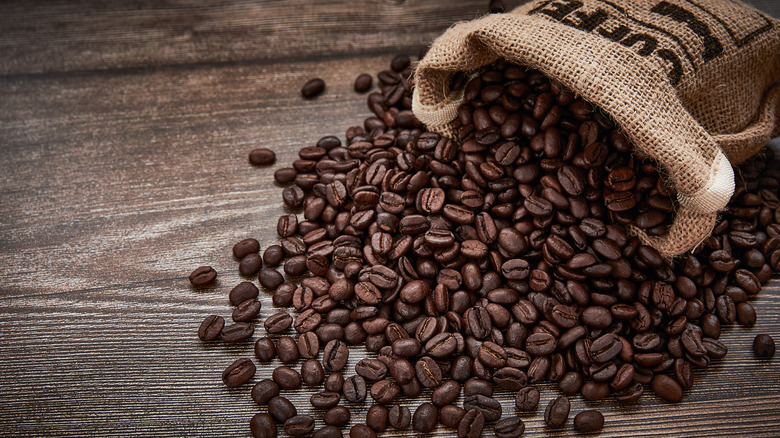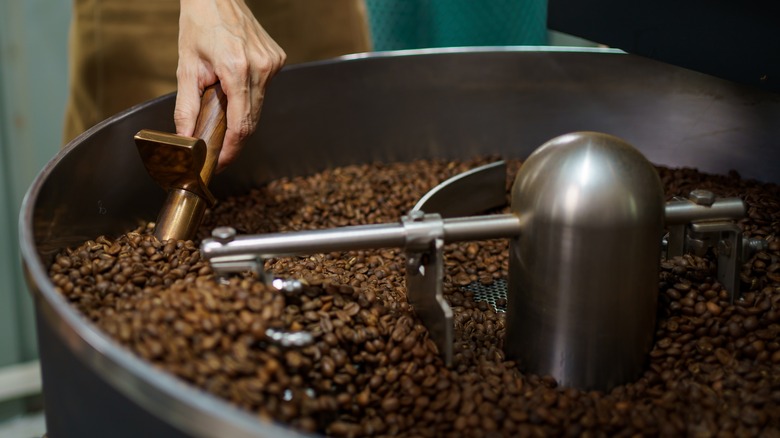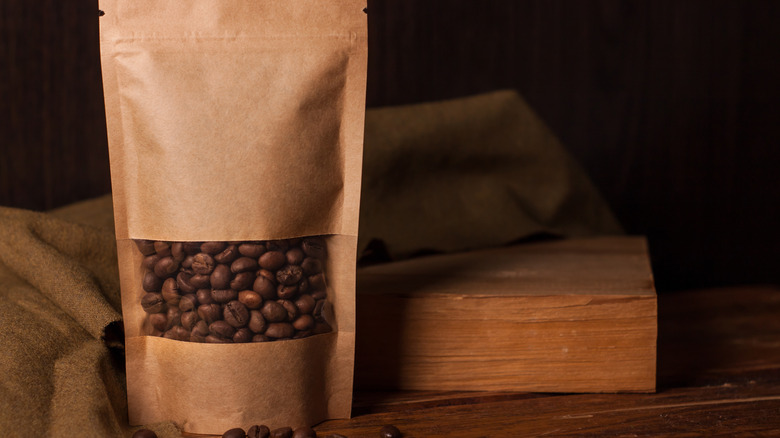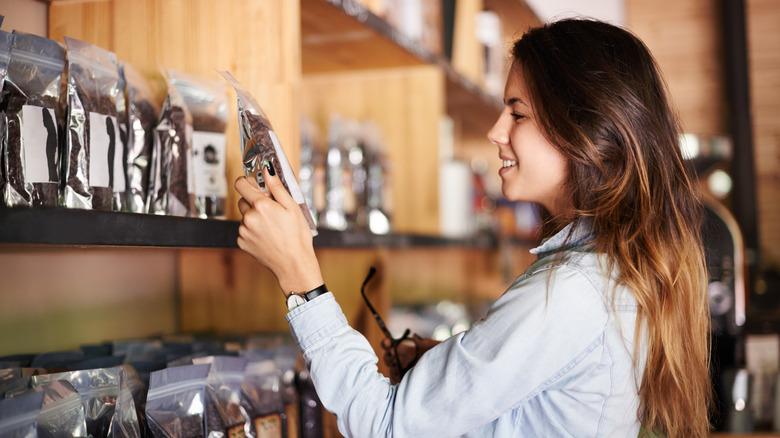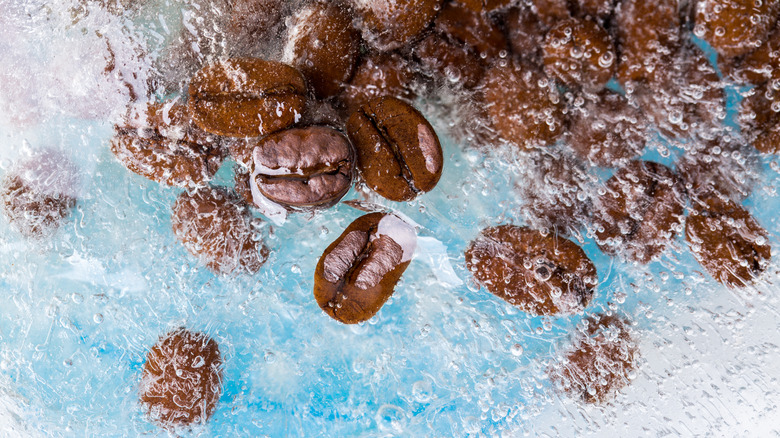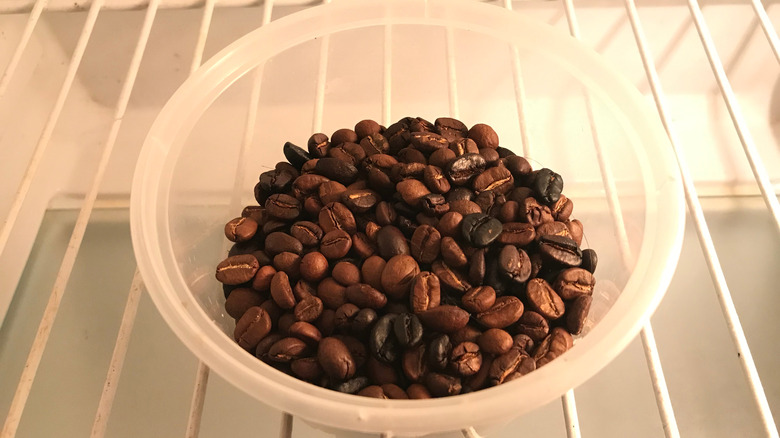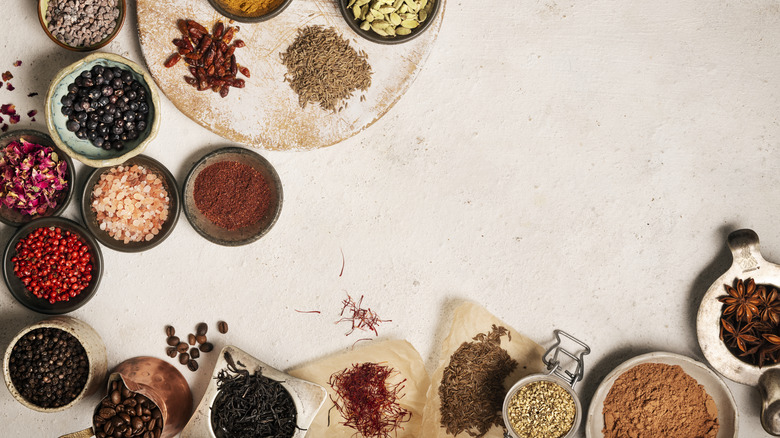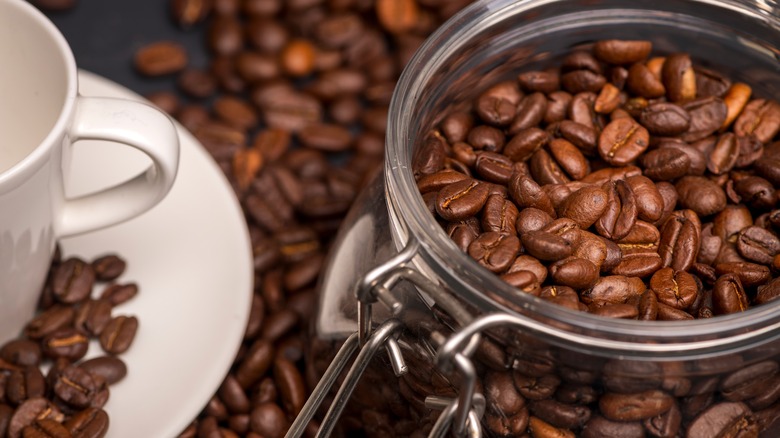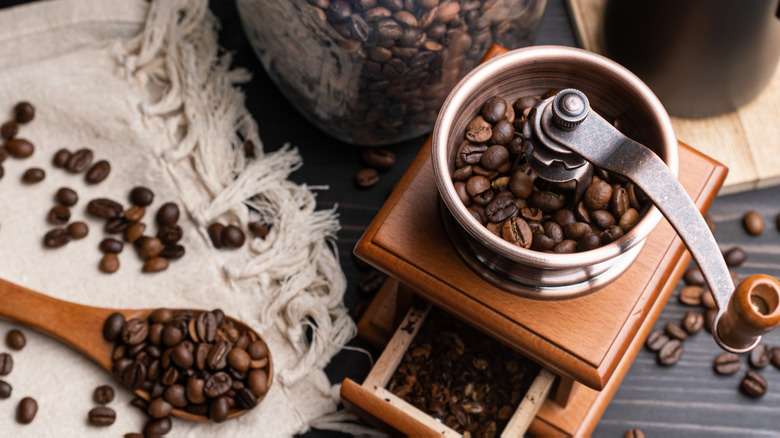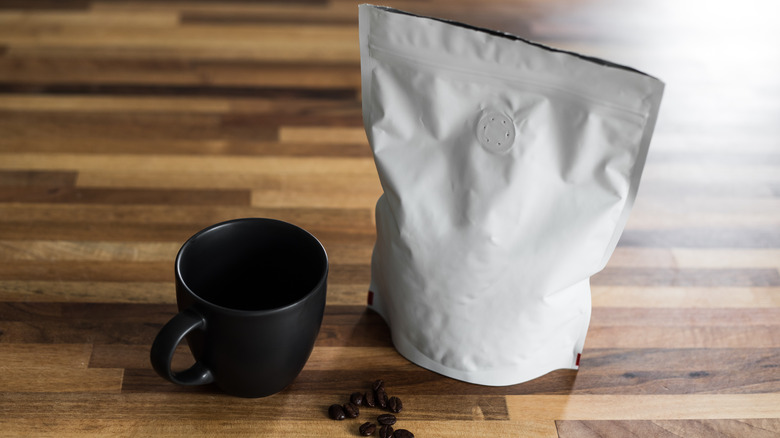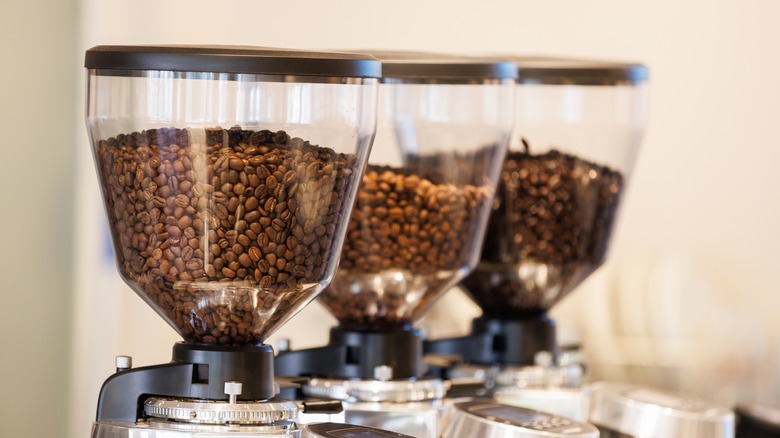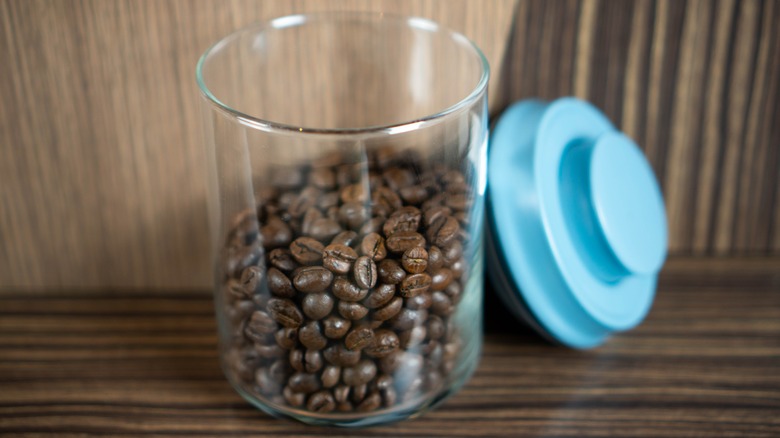12 Mistakes People Make When Storing Coffee Beans, According To The Experts
When you're ready to up your at-home coffee game, you know it's time to upgrade from tubs of grounds to buying freshly roasted coffee beans. Even if you agonize over the best science-led way to brew coffee and bring home the best coffee beans, however, you might be making some simple storage mistakes that are limiting your beans' maximum potential. Heather Perry, a two-time U.S. Champion Barista and CEO of Klatch Coffee, tells us, "The problem with coffee is that to the naked eye, it never goes bad. It won't mold like bread or rot like fruit, but that doesn't mean that it will provide you with a good experience or good flavor. The freshness of your coffee is hugely impactful on flavor and aroma."
It turns out our beans are sensitive to several elements in the kitchen environment, so you'll want to ensure you're storing them correctly to keep them from going bad, especially if you're paying more for high-quality coffee beans. As Johny Morrisson, founder of Coffee About, explains, "The main culprits are exposure to air, moisture, heat, and light."
We consulted coffee experts to detail the most common mistakes we make not just when making coffee at home, but when storing coffee beans, and how we can correct them for the best cup of joe.
1. Not understanding how the roast affects coffee beans
Before roasting, your coffee beans aren't actually beans. Instead, they're soft seeds extracted from a berry. These seeds are roasted to high temperatures and quickly cooled for the perfect bean. Yet "Once coffee beans are roasted, the clock is ticking," Perry advises. "While it's tempting to brew coffee from beans that were just roasted, you may actually want to wait a few days. Check the 'roasted on' date on the bag so you can allow some time before grinding and brewing."
Ceurwyn, from Welsh coffee company Coffi Dre, details, "Once coffee is roasted it starts emitting CO2 and once it has expelled all of the CO2 the coffee tends to then taste flat and 'off.'"
Additionally, light and dark roasts require slightly different supervision. "While the basic storage principles remain the same for all roasts, lighter roasts tend to retain their flavor longer than darker roasts," Morrisson explains. "This is because darker roasts have more oils on the surface, which are more susceptible to oxidation. Coffee beans reach their peak flavor about 2-10 days after roasting, depending on the roast level. After that, they start to lose their complexity and aroma. I always recommend using beans within two to four weeks of the roast date for the best flavor experience."
"Coffee is a living, breathing thing –– get in tune by experimenting," Perry encourages. "Your specific coffee might be best immediately after roasting, after a few days, or a week."
2. Leaving them in store packaging
Whether you've chosen something shiny or gone for the minimalist brown paper bag, you might be tempted to store your coffee beans in the original packaging for simplicity's sake. But maybe an extra step is worth it. "Store packaging is appropriate –– until you open it," Perry says. "Once you cut open the bag and leave it open, you're allowing all the important gasses to escape. Oxidation begins when newly-roasted beans are exposed to the air. Some oxidation is unavoidable, but you need to take preventive measures to slow it down, ensuring your coffee can last longer."
Morrisson explains you shouldn't leave coffee beans in the bag they came in because, "Most store packaging isn't designed for long-term storage or maintaining freshness. These bags often allow air to enter, which accelerates the degradation process of the beans."
If you're budget-conscious or don't have an appropriate container at home, not all packaging is necessarily bad. "Some store packaging (if it's resealable and air tight) is perfectly adequate for storing beans," Ceurwyn mentions. "Keep the coffee in the bag it came in if it has a seal and remove as much air as possible before resealing."
"Remember, freshness is key to great coffee," Perry concludes. "Think of that bag of chips that you left open, the next day they are stale and flat, just like your coffee will be if you leave it exposed. Once opened, transfer beans to an airtight container if they won't be used immediately."
3. Storing too many at a time
For those of us who want variety or like to stock up, Morrisson would like to have a word: "The biggest mistake I see is people treating coffee like it's non-perishable. They buy in bulk, store it improperly, and then wonder why their coffee doesn't taste great. Coffee is a fresh product and should be treated as such!" Just like many of us tend to buy fresh produce on a weekly basis, we should rethink buying coffee in large batches.
"For the absolute best cup, buy and store only what you can use in the short-term –– like one to two weeks," Perry recommends. "This is a good reason to buy smaller bags of fresh-roasted beans as you need them, instead of purchasing and storing larger bags that will take months to consume. Subscription services are ideal for putting delivery of small quantities of fresh-roasted beans on autopilot -– no last-minute trips to the store."
If you've been hoarding some java beans, how can you tell if they've lost their kick? "You may notice old coffee is lacking in flavor and aroma, or worse, has a distinct musty smell," Perry says. "To evaluate coffee beans, use your eyes, nose, and sense of touch. The roasting process encourages natural oils within coffee beans to rise to the surface; fresh beans should be shiny." Ceurwyn adds, "You can also tell by the smell of the beans and in my opinion it starts to smell like instant coffee."
4. Freezing the beans the wrong way
Ask the Internet about freezing coffee beans and you'll undoubtedly get some mixed results. The truth is more nuanced. "Storing beans in the freezer is a good way of keeping the freshness of the coffee," Ceuwyn admits. "If you know you 're going to take longer to use the coffee, then storing it in an airtight container/bag in the freezer is perfectly acceptable in our opinion."
It seems the mistake is not necessarily chucking them in the freezer, but not freezing the beans the right way. Beans that sit in open containers or are constantly removed risk rapid degradation. Perry shares, "Freezing coffee is often proposed as a low-cost alternative. It's understandable — you want your specialty coffee to last. But be aware — when you thaw the beans, they can start absorbing moisture from condensation, which can ruin the crucial oils that hold the flavor of your beans. For this reason, you should use it all immediately after taking it out of the freezer. If that doesn't work for your usage habits, larger batches can be frozen by pre-portioning them into smaller individual batches, each of which can be independently thawed when needed."
Instead of waiting for the frozen beans to thaw, you can also grind them straight out of the freezer. "Some say that grinding frozen coffee beans gives you a more consistent grind and in turn brews better coffee," Ceurwyn encourages.
5. Keeping them in the fridge
When storing coffee beans, Perry reminds us to stick to the basics: "Keep the container in a cool, dry place away from light, heat, and moisture." Be careful not to treat your beans exactly as you would fresh produce, though, which means you shouldn't equate that cool place with the fridge. While it's true you can keep your fridge smelling fresh with coffee grounds, their foul odor-absorbing power is the same reason you'll want to avoid refrigerating them. "The fridge is one of the worst places for coffee beans," Morrisson explains. "It's humid and full of odors that the beans can absorb. Plus, the constant temperature changes when you open and close the fridge door can cause condensation on the beans. The main issue is that coffee beans are hygroscopic — they absorb moisture and odors from their surroundings, which degrade their flavors. Even if you store the beans in perfectly sealed containers in the refrigerator, it will not provide any benefit."
Ceurwyn takes a more straightforward approach: "Storing beans in the fridge has no real reason other than using up space in your fridge." If you've mistakenly refrigerated your beans, check if they've retained any of their robustness. Morrisson points out, "In extreme cases when the beans are exposed to moisture, you might notice a mold growth or rotten scent, which is a clear indicator that the beans should be discarded."
6. Storing them near strong smells
Besides perking us up, what we love most about that first sip of morning joe is its jolt of earthy, bitter goodness. "Each coffee has a unique flavor profile that's been carefully curated by the roaster," Perry reminds us. That perfect blend of flavors is exactly what we aim to protect when we store our coffee, but we might be mistakenly keeping our beans next to some of their kitchen foes. "If you're going to consume the coffee within three weeks, then storing it in a cool, dry, dark cupboard away from any strong smelling food is perfectly adequate as long as it's in an airtight container," Ceurwyn says.
It turns out that coffee's most sought-after component — caffeine — is also why we need to protect it from the more pungent smells in our kitchen. Because caffeine is rich in nitrogen, coffee is particularly adept at adsorption, the ability to soak up foul odors like sulfur from its surroundings. While used coffee grounds are great as household deodorizers, the last thing you want is your beans to take on a distinctly garlicky aftertaste. Morrisson puts it simply: "Keep coffee away from strong-smelling foods like spices or onions –– remember, coffee absorbs odors easily."
7. Keeping the beans somewhere warm
Picture this: the late-afternoon sun hits your kitchen just right and pretty soon your coffee beans aren't just sitting on the counter — they're sunbathing. "Storing coffee in a warm environment speeds up the degassing process and makes the coffee 'go off' quicker," Ceurwyn cautions.
Coffee beans are particularly sensitive to light and heat thanks to oxidation. "Heat speeds up the oxidation process, which in turn affects the flavor and aroma of your coffee," Perry follows up. "Some oxidation is unavoidable, but take care not to needlessly accelerate it with careless storage. That means [storing them] away from the stove and away from windows. Even the light from a window on a warm afternoon can be too much –– a dark pantry is ideal."
According to most estimates, coffee bean's degradation doubles with every 50 degrees Fahrenheit increase in temperature, meaning you'll want to store them somewhere that's both cool and stable. Think about the spots you might not have even considered as harmful for your beans. "Avoid storing coffee near the oven, on top of the fridge, or next to the dishwasher. These areas can expose the beans to heat and humidity," Morrisson advises.
8. Using transparent containers
You've just bought the perfect mason jar, filled it with your favorite roast, and set it on a pedestal to display in the kitchen — but you may be doing more harm than good. "While those glass jars look great on the counter, they're not doing your coffee any favors," Morrisson says. "Light exposure degrades coffee beans rapidly. In a clear container, you might notice flavor loss within a week or two." Because light is one of coffee's greatest enemies, a see-through container will also bring excess heat, speeding up the aging process and compromising the richness of your beans. "An opaque container can help your beans stay fresh for one to two months when stored properly," he recommends.
"This is the same reason most craft beer is shipped in dark-colored bottles — to protect it from light before it's consumed," Perry adds. "We'd encourage you to think about fresh-roasted coffee just like fresh produce — it has a shelf life and a window after it's harvested during which it will taste best. Extend that window by using an opaque container and storing the coffee away from light sources."
If you're unwilling to part with your mason jar, there's a possible workaround. "A simple mason jar can work wonders if you're on a budget," Morrisson reassures. "Just wrap it in a dark cloth or store it in a dark cupboard to protect from light. And always make sure the lid seals tightly!"
9. Pre-grinding all the beans
Maybe you can't stand the roar of your coffee bean grinder everyday and we get it. Early mornings and loud noises aren't a great match. What you might save in time and convenience by grinding beans in large batches, however, you'll pay for with the integrity of your coffee. Ceurwyn admits, "Grinding the coffee in one go instead of grinding just before they brew," is one of the most prevalent mistakes people make when storing coffee beans.
"Grind immediately before brewing," Perry remarks. "Speciality coffee roasters want you to have the best possible cup. While some drinkers might choose to grind all the beans at once, we'd encourage you to grind only what you need, while storing any remaining beans in an airtight container. Grinding increases the surface area of the coffee, which in turn increases exposure to the air, speeding up the oxidation process. Don't unnecessarily speed it up by grinding more beans than you need."
"Pre-grinding is convenient, but it significantly shortens the coffee's shelf life," Morrisson says. "Once ground, coffee starts losing its flavor in minutes. If you must pre-grind, only do enough for a day or two at most and store them properly in a sealed container. There is a simple rule for coffee aficionados: Grind within 15 days of roasting and brew within 15 minutes of grinding!"
10. Using a container with a valve
You're faced with a lot of options when searching for the right storage for your coffee, but that bag with the one-way valve isn't the most effective at prolonging your beans' flavor and shelf-life. "Those valves serve a unique purpose — allowing carbon dioxide to escape, while preventing oxygen from entering at the same time," Perry explains. "After roasting is complete, the de-gassing process (during which carbon dioxide is released from roasted beans) starts immediately, and can take several days. It's important to allow carbon dioxide to escape during this process, thus the valve."
Although one-way valves allow roasted beans to continue the natural degradation that will bring them to their prime, these bags are not ideal. "While valve containers are better than nothing, they're not as effective as vacuum canisters," Morrisson comments. "Valve containers allow gasses to escape but don't actively remove air from the container. Vacuum canisters, on the other hand, remove the air entirely, significantly slowing down the oxidation process."
Having a vacuum canister may be the best way for java aficionados to store their beans at home, but it's still an encouraging sign if the coffee you order online arrives in a bag with a one-way valve. "The one-way valve allows de-gassing to occur while the coffee is in transit during the shipping process, so no additional waiting is needed once your coffee arrives," Perry says.
11. Leaving them in the grinder hopper
At first thought, storing your beans in the grinder hopper makes all the sense in the world, as it requires less opening and closing of containers, minimizes air and light exposure, and speeds up the path to your morning coffee. Besides, if it's what they do at your local coffee roasters, it must be best practice, right? Think again: "The hopper isn't airtight and shouldn't be used for long-term storage," Perry says. "In brick-and-mortar cafes you may notice beans kept in the hopper, but realize those are scenarios with extremely high turnover –– often just a matter of hours. For home users, storing beans in the hopper isn't a good habit to develop."
Morrisson concurs. "I strongly advise against this practice. Storing beans in the grinder hopper exposes them to air and light constantly. Plus, the oils from the beans can build up in the grinder, affecting future brews. It's best to only put in the grinder what you plan to use immediately."
If you've neglected to measure out your coffee beans (which you should always do, by the way) and left some in the hopper for a bit too long, you can still test them for freshness. "There are a few ways of seeing if your coffee is past its best," Ceurwyn explains. "When brewing coffee with a filter it tends to bloom less or when pulling an espresso shot with old coffee you tend to get less or no crema on the top."
12. Forgetting to close your container
So you're buying small batches of coffee beans and storing them in an air-tight container in the cupboard. Now, it's finally time to enjoy your brew. To avoid another big mistake, Ceurwyn shares a simple piece of advice: "Keep the container open for as little time as possible." Maybe you're a bit scatterbrained in the mornings, but if you forgot to re-seal the container after scooping the beans out, you're exposing them to excess air and light and letting them go stale faster. "Try to limit the time your container is open to less than a minute," Morrisson advises. "I recommend using a scoop that's already in the container or having your scoop ready before opening to minimize exposure time."
If you're starting to feel like your coffee beans will go bad if you look at them the wrong way, don't fret. "It's inevitable that you'll eventually need to open the container," Perry says. "Just scoop out what you need and immediately close the container. If you're concerned about opening the container daily, consider portioning out the beans into smaller containers, each with enough beans for a couple days."
